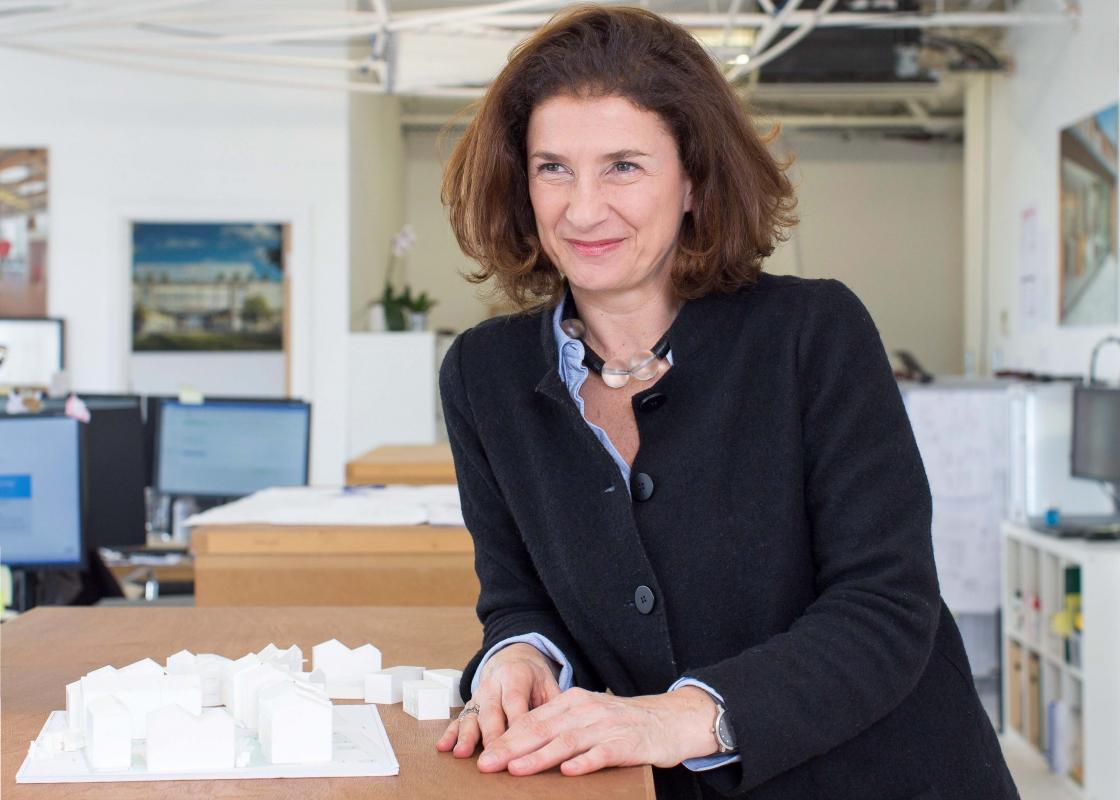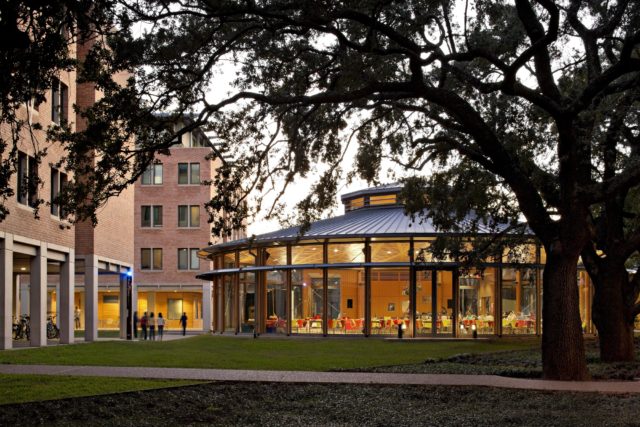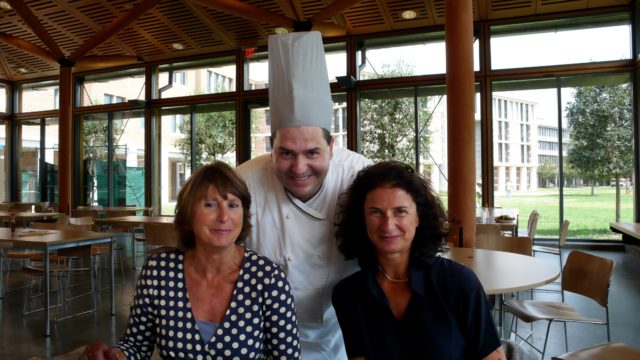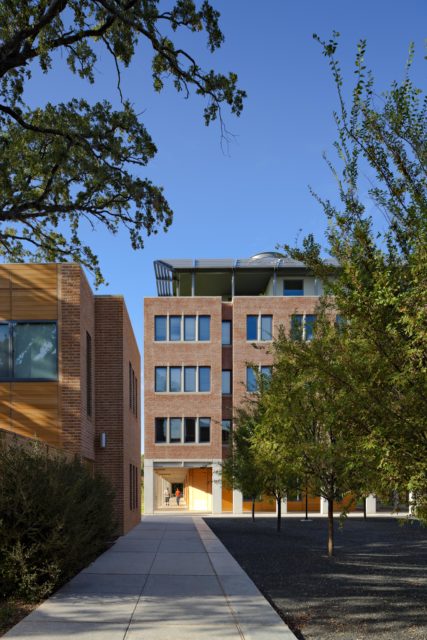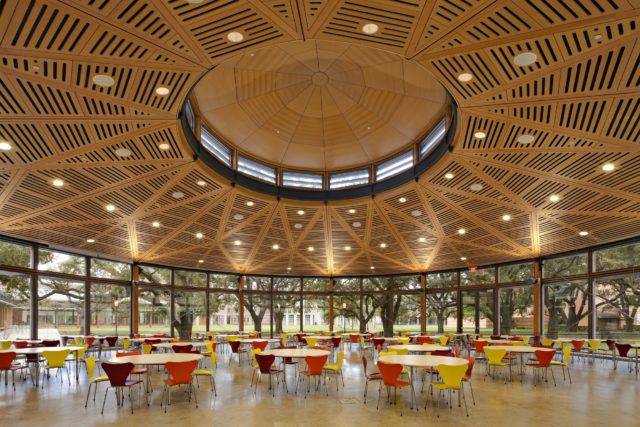Laura Carrara-Cagni is a director at Edward Williams Architects with significant experience in designing, managing, and delivering large public projects such as hospitals and university buildings. For several dormitories at Rice University, she collaborated with Andrew Albers, who is a vice president with OJB Landscape Architecture, a lecturer at Rice Architecture, chair of the Cite editorial committee, and recipient of the 2018 Ben Brewer Award from AIA Houston. Andrew met with Laura to reflect on her time spent working with Rice University and on her experience as a London-based Italian architect.
Andrew Albers: Please tell me about yourself.
Laura Carrara-Cagni: For the first four years of my life I lived in London then moved back to Italy and moved every four to five years. I went to Genova University. I graduated in the middle of the 1992 Italian economic crisis, started a studio with university friends, and subsequently got a European Community scholarship to work in France for two years. I then moved to Texas for one year before returning to Europe and settled in London where I have been living since 1998.
AA: Your most recent connection with Houston are projects at Rice University. Could you tell me about those?
LCC: I was working in London for Hopkins Architects. Because of my past links with Texas, I have friends and family there. When Rice University asked Michael Hopkins to design two new colleges, I asked to get on the project. I was the project architect and in the end we built ten new buildings for Rice University over a span of five years. I was traveling to Houston one week every month.
All that traveling was well worth it and I am very proud of our Rice University project. We built the new Duncan and McMurtry Colleges, a total of seven buildings, two college buildings, two serveries, two master’s houses, and one kitchen/servery. We started in 2006 and completed in 2009. A year before we finished, we got involved in masterplanning the south colleges, for an area that covers Baker, Will Rice, Lovett, and Syd Richardson Colleges. Following the masterplan study we built new college wings and adjusted some of the old buildings. We completed those in 2011.
AA: What drew you to architecture?
LCC: Hmmm. I didn’t start off with architecture. I wanted to be an interpreter and travel. I started reading languages at university and was helping a friend who was studying architecture and realized I was having a lot more fun helping her than with my own studies. With languages I didn’t feel like I was learning a job; with architecture I could change the built environment and that was exciting!
AA: Do you have a particular process when approaching a particular architectural problem?
LCC: First off, I need to get a deep appreciation of my clients and their requirements, become involved, and understand their organization.
For Rice University, I spent a lot of time with students, or going around the kitchens, talking to chefs, really trying to absorb campus life as they lived it and, of course, the operational side. Then after some creative thinking, we went back and forth to make sure everyone was involved and participating. We worked with Hanbury, an architectural firm based in Virginia. They were the execution architects and had a lot of experience with student housing, so everybody was bringing their best experiences to the table. That’s what I like, a collaborative process where ideas are shared, and the project is continuously improving. You keep refining it, making sure the client is absolutely comfortable with every minute detail of it. That type of process is always a valuable learning experience for all of the design team.
AA: Is there a formal process or does the form evolve from the conversation?
LCC: The architectural form? There isn’t a preconceived form. I quote my professor on this. “There isn’t good or bad in architecture, it is how you do it.” Form follows culture and location, the genius loci, and how it is processed. We use our cultural knowledge to make the right choices for every project, making sure it holds together, by continuous testing, and being true to materials through detailing. We use client feedback to review and improve, making sure it all comes together. What we do is very tailor made.
Buildings that have an identifiable designer signature are not necessarily of a high standard. That’s not what we do. We try to get the buildings right, beautifully right for each location. If we have a language it is of very intelligently crafted buildings. We go very much into the detail so our buildings are very well made. We like the building to show how it is put together, how it works. We don’t hide the structure. We don’t cover things up if we can.
AA: You left Hopkins and are now with Edward Williams Architects?
LCC: Yes, we started the firm in 2011. Edward and I met at Hopkins. He left in 2011 and started the practice. I joined him a year later. It’s been - it still is - seven years of a lot of fun, and hard work.
AA: What was the evolution from how you would do things before you started the firm and now? Is there a different approach to architecture.
LCC: We both come from 15 to 20 years designing major public buildings. We thought we were going to start with house extensions, working from the local pub. Instead quite quickly we got the Proton Beam Hospital project in London from an old client who liked what we did. So we grew quickly, doubling our staff every year. Straight after doing the Proton Beam Hospital in London, we were appointed to design the biggest emergency center in Europe, in Birmingham. So we kept growing. We are very proud of our people and our office culture. We are multicultural and many of us are female. In fact there was a time the team started complaining that there were not enough men and we had to rebalance. We certainly don’t have a gender problem in our office.
AA: Who was a mentor of yours or a person who had a big influence on you?
LCC: Giancarlo De Carlo. He ran a fourth and fifth years design studio at Genova University. It was incredibly selective and demanding. We started with 180 and ended with 30. It was very, very hard but Giancarlo was very charismatic. He was driving us to put 100 percent of our time day and night into this learning experience. At the beginning we were constantly throwing ideas away and starting from scratch in search of the right one, until we learned that there is no absolute right or wrong. He wanted to see how we did it.
I wouldn’t be the architect I am today without him. He made us question ourselves a lot. He said no to strict design rules; there is society, urban planning, people, and several other factors you have to account for. Unless you learn this you are not going to be a great architect. He taught us a lot about participation, what you are doing in relation to who you are doing it for.
AA: Have you had any breakthrough moments in architecture?
LCC: Assuming you mean a moment of success, the premise is that in architecture the project completion is a transition. Then, most of the time, the client takes ownership and gets that breakthrough moment. That’s probably a sign of success. Immediately the client associates themselves with the project and promotes it. I did a library in Norwich. I remember fighting like crazy over the color scheme and materials of the children’s library with the head librarian, who wanted something completely different. As soon as it opened, she was saying, “See what I did, it is fantastic!” I get a lot of that. The client takes ownership and then he/she comes back eventually because what you did in the first place was right. Those are “indirect” breakthrough moments.
At Rice, I had a particularly satisfying moment though. I was invited to talk to the students of one of the new colleges to answer their questions. I was warned that it might be challenging. I sat in front of about 50 students. They started asking questions and within five minutes they were all positive about what we had done. It made sense to them, they were smart students. They immediately started asking constructive rather than accusatory questions. They were interested. On the back of this experience, a few years later I was invited by another college to be a scholar in residence. Students are interested in the buildings they live in and how they work. I gave a talk and a walkaround. Two and a half hours later, in the dark, students were still asking me questions. Those moments give me a lot of satisfaction, to have created a built environment that changed people’s lives.
By email, you asked about the gender issue, I have some funny anecdotes about it. Take for instance a client of a large civic center we were designing in London who was unhappy because the consultant team wasn’t working. The firm’s senior partner introduced me to the client as the person who would resolve the problem. The client asked to have a word in private with the senior partner and said, “I told you the problem was serious and you bring me a girl?”
Thankfully, I didn’t know he said this until much later. A month later he emailed thanking me for the good work. It took a month, though, to prove it was OK to have a girl on the team trying to resolve problems.
AA: Was there a particular moment where you personally felt you had made it as an architect?
LCC: Straight out of university, I had a breakthrough moment when my article for Space and Society, the magazine directed by Giancarlo de Carlo, came out. It was an article on my thesis. When it was finally published, I was very pleased.
Nowadays when I go back to Italy, my Italian architect friends see what we have done with our practice; it has grown fast and we complete projects in a short time. They think I have made it. I never thought about it like that. We are always expanding, and are looking to the future. We are growing our people in the office, which is a great responsibility for us. We help them to develop as great architects, to understand the values and the wonderful responsibility of what we do.
AA: Women are often conditioned to be nice and expected not to make waves. Have you had any experiences with that expectation?
LCC: Where do I start?! The construction industry is one of the most male-oriented industries. In several instances being a woman proved an obstacle. A friend some years ago said he could see that when a woman reached a position of authority in this industry, the only way she could deal with it was by being either very tough or very flirty. I definitely take the tough approach. You have to show a tough hand to earn respect from your clients, consultants, colleagues. You do eventually earn the respect but it is harder for women and it is totally unfair. You have to use double the energy to make it.
When I came to the U.S., though, one of the things I enjoyed is that not once did I feel different because I was a woman. That’s why I regard the projects I did in Houston as some of the best I have ever worked on. The result is good because I was able to put all the energy in the projects rather than dispersing energies proving my value.
AA: Do you think that there was some self-selection with the project being a Rice project?
LCC: There is self-selection with an academic project. Houston is also very welcoming. In Texas I was able to contribute more as there was an open interest on the other side.
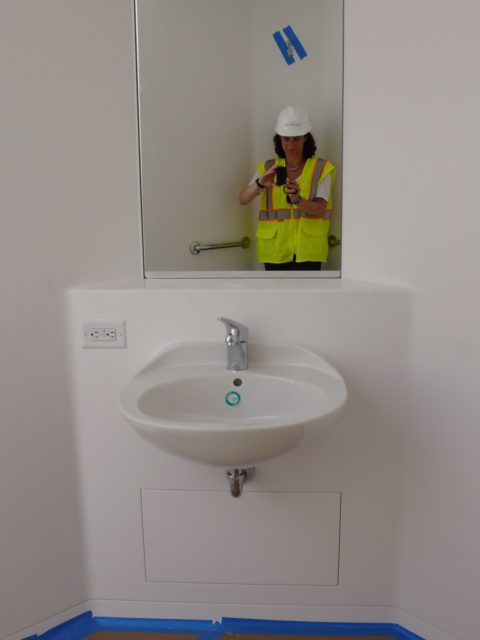 Checking installation of prefabricated bathroom for Duncan and McMurtry. Photo: Laura Carrara-Cagni.
Checking installation of prefabricated bathroom for Duncan and McMurtry. Photo: Laura Carrara-Cagni.
AA: Were there many women in the construction team? In the general contractor’s office, were there women working on the general contractor team as well as the architecture and design team?
LCC: On the first project, there were some women, but all very junior. On the second project there were almost none at all on the construction side. Woman do tend to be in support roles not in the project management roles.
AA: In England, are there more women in the construction management side?
LCC: It’s still something we are not seeing much of. On the hospital project we are building in Birmingham, there are very few women on the construction side.
AA: Do you think that because it is a tough environment, few people want to enter it or is it something that as you enter it, the nature of the environment would steer people to find something else?
LCC: People know the construction environment is quite aggressive and maybe fewer women are attracted to it than other industries. In the UK men go drinking at the pub and that’s how they bond. It is a “lads” culture. It’s still a male-oriented industry. Texas is different but it will take some time to change this culture.
AA: What do you think of our current cultural climate? And Brexit? There seems to be a particular spirit of politics today and it seems different than 10 years ago.
LCC: I’m not liking what I am seeing. Even the people speaking out about the recent gender scandals are questioned. You never know what is right or wrong. Social media is misused, everybody can put out any news. It is difficult to verify what comes out. We have political leaders who lie too. I see that in Italy, in the UK over Brexit, and in the American elections. The Brexit campaign was based on untrue information. People were told that a lot of money could be spent on the health system rather than for Europe, this is completely wrong. It will cost Britain considerable amounts to leave the European Union. People voted Brexit for reasons that had nothing to do with it. Populism is strong and not helping the already fragile political juncture. I am a convinced believer in Europe. Our culture should come together and build a unity which could counterbalance the Cold War, U.S., and Russian powers. Having an entity made up of different states would hopefully take sensible decisions for our lives.
AA: What do you think the next ten years will look like?
LCC: We are very excited about technological progress. We are looking closely at how driverless and electric cars are going to change our built environment. With vehicles becoming quieter, deliveries can happen even at night. With driverless cars, many car parks will be obsolete. When we are designing, we are looking at the flexibility of structures so they can be converted into other functions. We need to start thinking about interstitial space, densifying the city, adding quality to the urban landscape, making it more usable for everybody. Getting cars off the streets will help a lot. I am an advocate of refurbishing rather than only building new constructions. By adding value to what we already have or transforming it we enrich our living space. We need to ask ourselves questions about the built environment. Nowadays there is a lot of denial about sustainability, the environment, our air quality. Not enough is done about it. Technology is not focusing enough on those issues, helping us build a better built environment.
AA: What advice would you give others entering the profession of architecture?
LCC: You have to be very committed and never give up. It’s a hard profession but it is an important one. It’s the closest thing to creation. You have the tools to change the environment. You have to be very responsible. It is a learning process for the duration of a career, not only at university. You have to like learning and researching. But it is very gratifying. There is nothing like walking around and knowing how to improve the life of communities. If you are driven by that, you are right for this career. If you are not, don’t. It is one of the most difficult professions because you have to know about several other disciplines too. You learn to design buildings when you go to university. When you come out you have to learn about services, structures, art, and about any kind of user's function. If you are building a church, you need to know about religion. If you are building a museum, you need to know about art curating. That is both exciting and hard work.
Duncan and McMurtry Colleges Building Credits
Architects: Hopkins Architects, USA (design architect); Hanbury Evans Wright Vlattas (executive architect)
Landscape Architect: The Office of James Burnett
Engineers: CHP and Associates (mechanical); Haynes Whaley Associates (structural)
Project Management: Gilbane
Construction Contractor: Linbeck Group L.P.
South Colleges Building Credits
Architects: Hopkins Architects, USA (design architect); Hanbury Evans Wright Vlattas (executive architect)
Landscape Architect: The Office of James Burnett
Engineers: BDMI (mechanical); Architectural Engineers Collaborative (structural)
Construction Contractor: Tellepsen


